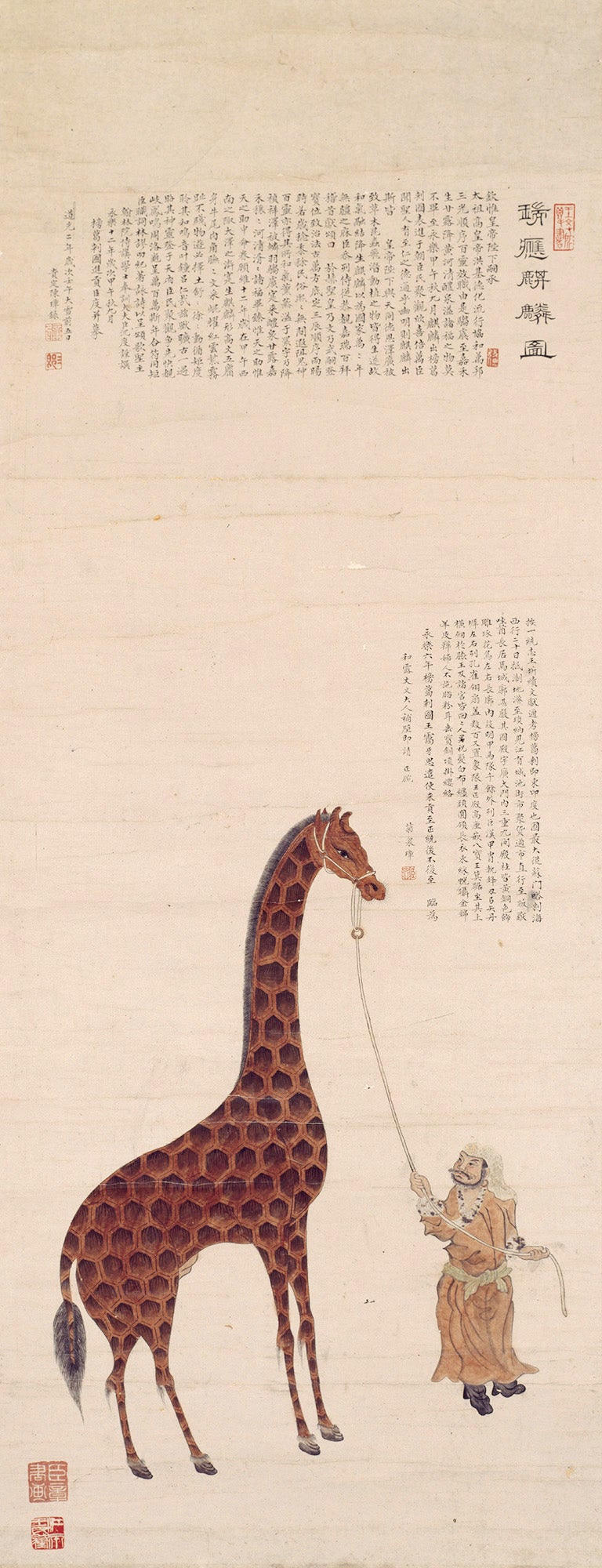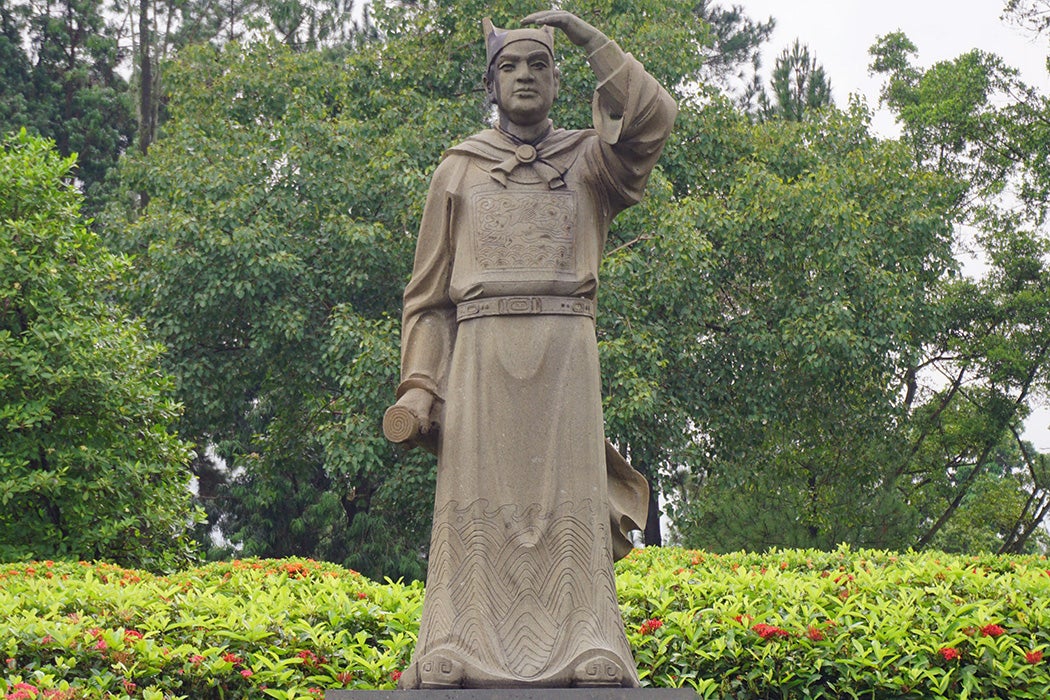Zheng He’s sixty-two years were filled with as many crests and chasms as the oceans upon which he sailed. During his life, he went from the son of a powerful political family to prisoner, servant to celebrated sea captain. As historian Geoff Wade describes, throughout a naval career that stretched 28 years, he traveled more than 31,000 miles and visited at least thirty-seven countries. The 317 ships he commanded contained more than 27,000 men—such an impressive fleet wouldn’t be assembled again until Britain’s Royal Navy in World War I, some 500 years later.
Throughout his seven voyages, Zheng He solidified Chinese trade routes and political influence from northeast China to southeastern Africa. Despite these dizzying achievements, details of his voyages were expunged from the official imperial records soon after he died, and historians have struggled to find contemporary sources providing details of his death. How did Zheng He go from surfing the wave of imperial power to a ghost barely visible in the footnotes of history?
Born in 1371 in Kunyang County in China’s Yunnan Province, Zheng He came from a noble Mongol lineage. His original name was Ma He, a tribute to his Muslim roots (Ma is the Chinese version of Mohammed), and he grew up listening to his father’s and grandfather’s tales of their Hajj—a pilgrimage to the Muslim holy city of Mecca (in present-day Saudi Arabia). When Ma He was around eleven years old, everything changed, however. A raid on Kunyang by soldiers of the Hongwu emperor, Taizu of Ming, resulted in the murder of his family. Ma He was captured, castrated, and carried to the imperial court to serve the emperor’s fourth son, Zhu Di.
The Ming court at the time was defined by pageantry and propaganda. Ma He helped organize military displays and elaborate hunting tournaments, gradually earning a name by his hard work and strength. He became Zhu Di’s bodyguard and was eventually promoted to the advisory role of Grand Eunuch (the highest rank a eunuch could achieve). In 1404, Ma He was “honored” with a new name, Zheng, severing him from his Muslim heritage forever—or so Zhu Di thought.
When Zhu Di launched a successful coup against his nephew, the Jianwen Emperor (Huizong of Ming), Zheng He followed his leader and became a valued figure in the new administration. When Zhu Di ordered the construction of the biggest fleet the world had ever seen, Zheng He was the obvious choice to oversee the birth of his vision.
Over the next twenty-eight years, Zheng He’s behemothic fleet completed seven journeys that became known as the “Treasure Voyages” due to the huge quantity of porcelain, silk, and spices stashed aboard the 440-foot-long ships. Although scholars in China traditionally refer to these as “voyages of friendship”—and Zheng He did prove to be a masterful diplomat—some scholars paint them as “aggressive attempts to achieve a pax Ming in the Asian maritime realm…and to dominate the trade routes linking the Middle East and East Asia,” writes Wade. Certainly, by the end of his career, Zheng He had successfully positioned China as the Middle Kingdom, with foreign powers as far away as east Africa viewed as vassal states required to pay regular tributes to the Ming court.

Zheng He’s adventures were dashing and bloodthirsty in equal measure. In 1407, returning from the first mission abroad, Zheng He’s men captured Chen Zu-Yi (Ch’en Tsu-i), one of the most feared pirates of southeast Asia, writes Wade. A second voyage, departing in 1408, saw the fleet carrying gifts to the king of Calicut (present-day Kozhikode on the Malabar Coast of India) and intervening in a military dispute in Java. In 1411, during the fleet’s third voyage, Zheng He attacked Ceylonese naval forces and successfully led a ground invasion to capture the king, Alagakkonara, who was subsequently taken to the Ming court as a prisoner. During a fourth voyage, Zheng He paused at Samudera, then a major polity on the north coast of Sumatra, where his men kidnapped a usurper who’d murdered a ruler who was more sympathetic to the Ming. A fifth voyage took the fleet to Malindi on the East African coast, writes Barbara Bennet Peterson. There, they picked up numerous ambassadors—as well as boat loads of baffled animals including lions, camels, giraffes, and ostriches, which fed the emperor’s taste for the exotic.
Weekly Newsletter
In 1424, the Hongxi Emperor, Zhu Gaochi (Chu Kao-chih), came to power, and Zheng He’s high position in the court came crashing down. Possibly due to the number of barbarians flooding over the border from Mongolia, the Hongxi Emperor saw little need to continue the overseas voyages, writes Peterson; he instead turned his attention to the Great Wall project. At the same time, scholars of the fifth-century BCE philosopher Confucius were promoting the idea that China should isolate itself from outside influences in order to preserve its culture. Zheng He was relegated to the Nanking garrison, some 300 kilometers from the ocean.
However, in 1430, the Hongxi Emperor reassembled the great fleet for one more voyage, writes Peterson, calling Zheng He back to the admiralty. The fleet sailed to Java, Sumatra, and several other Asian ports before arriving in Calicut, where Zheng He commissioned two envoys to undertake a Hajj on his behalf, a customary practice at the time, explains Gary Paul Nabhan. Zheng He never forgot his Muslim roots, it seems. Though he stayed in Calicut rather than travel to Mecca, this seventh voyage would turn out to be the first time he wasn’t at the helm for the entire mission. In 1433, still in Calicut, Zheng He died of unknown causes, leaving his treasure ships to be sailed home by someone other than the greatest admiral of the Ming dynasty.







